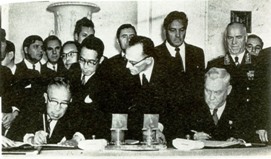History of the Northern Territories issue
1. Islands developed by Japanese
Islands of the Northern Territories began to appear in history
in the early 17th century. According to Shinra no Kiroku
(Record of Shinra), produced by the Matsumae Domain, which
ruled over Ezochi (Hokkaido), people in the domain traded sea
otter fur and eagle feathers with Ainu people, and it was
known that there were islands where such goods were produced.
The shogunate ordered all domains in the country to submit their
maps in 1644 (Shoho 1), in order to create the Shoho Map of Japan.
The map submitted by the Matsumae Domain shows island names from
which present islands can be inferred, such as “Kunashiri” and
“Etohoro.” This map is thought to be based on the exploration of
Ezochi by retainers of the Matsumae Domain in 1635 (Kanei 12).
In 1715 (Shotoku 5), the Matsumae Domain submitted a report to
the shogunate, saying, “The main island of Hokkaido, the Kurile
Islands, Kamchatka, and Karafuto are governed by the Matsumae Domain.
The Ainu live in these areas, each of which is led by a chief,
but the Matsumae Domain has overall control.”
The Matsumae Domain initially traded mainly at Akkeshi with Ainu
from Kunashiri and Etorofu, but it expanded its trading area to
Kiritappu and Nemuro’s Notsukamappu. In 1754 (Horeki 4), the Matsumae
Domain opened a basho (trading post) on Kunashiri Island to exert
greater influence over Kunashiri Island and Etorofu Island.
Meanwhile, Russia was steadily advancing into the Far East. It
is said that Russians first entered the Kurile Islands and
conquered Shumushu Island in 1711 (Shotoku 1). Peter the Great
(reign: 1682 – 1725) became interested in the east, and just
before his death, he ordered Captain Bering to explore the
area. Following this order, an expedition was organized. The
Russian naval officer Martin Spangberg, a member of the
expedition, advanced southward through the Kurile Islands in
1738 (Genbun 3) in search of a sea route to Japan and arrived
on the coast of Japan in the following year.
The
shogunate, which learned of Russia's active southward
advancement, embarked on a full-fledged survey of the northern
region and dispatched an expedition to Ezochi in 1785 (Tenmei
5). The expedition traveled to Uruppu Island over the course
of two years and learned of the situation of the islands and
Russia’s southward expansion. Mogami Tokunai, a well-known
explorer, joined the expedition.
After that, incidents continued to jolt the shogunate, such as
Laxman's arrival at Nemuro and visits by British ships to Ezochi.
In the interest of national defense, the shogunate decided to put
Ezochi, including Chishima and Karafuto, under its direct control
and dispatched a large-scale patrol to Ezochi in 1798 (Kansei 10).
At this time, Kondo Juzo, erected on Etorofu Island a "national
station pole" inscribed with the words “Japan’s Etorofu.”
The shogunate, which decided to take direct control of Ezochi,
immediately launched the development of Etorofu Island, which borders
Russia. Kondo Juzo crossed over to Etorofu Island with Takadaya
Kahei and others to establish a “village system” that incorporated
the administrative system of the mainland and to open 17 fishing
grounds. They also developed sea routes and ports, and sent retainers
from the Nambu and Tsugaru domains to fortify the defenses of Kunashiri
and Etorofu. In this way, the full-scale development of Shikotan,
Kunashiri, and Etorofu islands began.
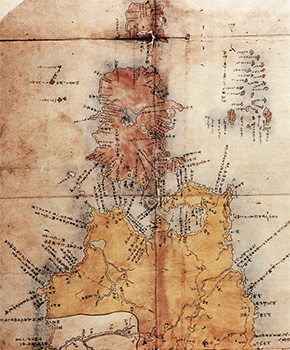
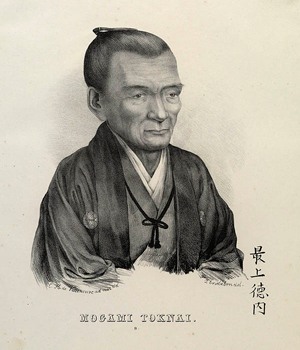
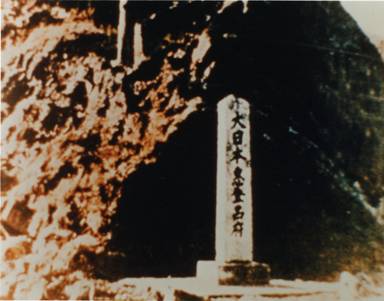
2. Conflict and agreements regarding the border
Various incidents and conflicts arose as Russia's southward
expansion strengthened. In 1804 (Bunka 1), Nikolai Rezanov, an
envoy of the Russian Emperor, was denied trade with Japan, and
he ordered his subordinates to attack Karafuto and Etorofu
Island, setting fires, committing assaults, and looting.
The shogunate ordered the Russian ships to be destroyed, and in
1811 (Bunka 8), Major Golovnin, the commander of the Russian frigate
Diana, was captured. Vice Commander Rikord attacked a Japanese
ship in retaliation and captured Takadaya Kahei, a pilot of the
shogunate. Thanks to Kahei’s great efforts, Golovnin and Takadaya
Kahei were released and exchanged. This incident prompted the two
countries to begin discussions to determine borders.
In 1853 (Kaei 6), the Russian Emperor Nicholas I dispatched
Admiral Putyatin to petition for trade and to offer to
demarcate the border between Karafuto and the Kuriles. After
several unsuccessful rounds of negotiation at Nagasaki, the
talks were moved to Shimoda (Shizuoka Prefecture) in February
1855 (Ansei 1), where they continued. The Treaty of Commerce,
Navigation and Delimitation between Japan and Russia was
signed on February 7, and the border between Russia and Japan
was demarcated.
Under the treaty, the border between the two countries was drawn
between the islands of Etorofu and Uruppu, and it was decided that
the islands south of Etorofu would be incorporated into Japanese
territory and the islands north of Uruppu would belong to Russia.
However, no agreement was reached on Karafuto, which remained an
area inhabited by a mix of two peoples with unsettled borders.
Column
Japan’s first smallpox vaccination: Nakagawa Goroji
When Rezanov's men attacked Etorofu Island, Nakagawa Goroji, the head of the local guards, was captured and taken to Siberia. He made numerous unsuccessful attempts to escape and finally returned to Japan at the time of negotiations on a prisoner swap involving Golovnin. He worked as a physician's assistant during his detention in Russia, obtained a book on smallpox vaccination, and picked up skills. He administered vaccinations at Matsumae and Hakodate, where smallpox was rampant. This was the beginning of smallpox vaccination in Japan, from which the vaccination spread nationwide.
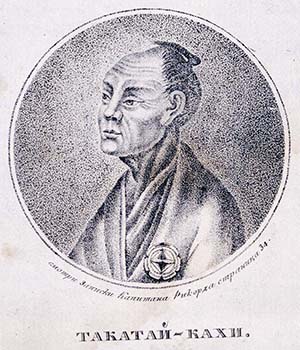
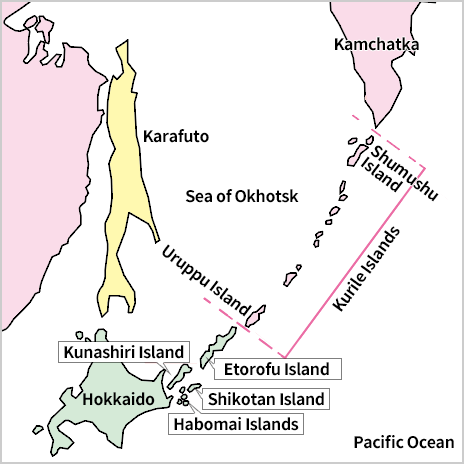
The Meiji Government was established, and in 1869 (Meiji 2),
the Development Commission was established to develop the
northern region. The Habomai Islands, Shikotan Island,
Kunashiri Island, and Etorofu Island were incorporated into
the “county system.”
In Karafuto, however, conflicts continued between Japanese and
Russians as Russia approached the main Japanese strongholds. To
break this deadlock, the Meiji Government dispatched Enomoto Takeaki
as a special envoy to Russia in 1874 (Meiji 7) and concluded the
Treaty for the Exchange of Sakhalin for the Kurile Islands with
the Russian Prime Minister Gorchakov on May 7, 1875 (Meiji 8).
Pursuant to this treaty, Sakhalin Island, which had been considered
an area inhabited by a mix of two peoples under the Treaty of Commerce,
Navigation and Delimitation between Japan and Russia, became Russian
territory, and the Kurile Islands (18 islands from Uruppu to Shumushu)
became Japanese territory.
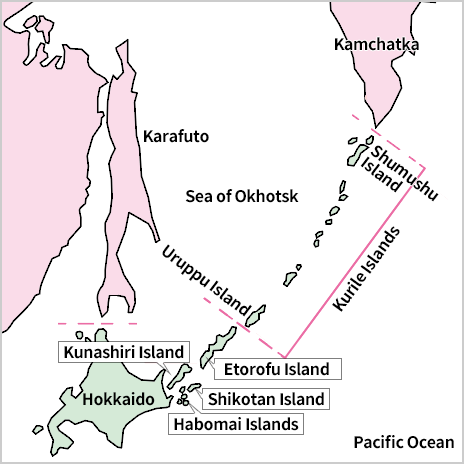
Russia continued to advance southward to Manchuria and Korea, and the Russo-Japanese War broke out in 1904 (Meiji 37). The war lasted 18 months and ended with the Portsmouth Peace Conference. As a result of the negotiations, the Russo–Japanese Peace Treaty (Portsmouth Peace Treaty) was signed on September 5, 1905 (Meiji 38), and the portion of Karafuto south of 50 degrees north latitude was transferred from Russia to Japan.
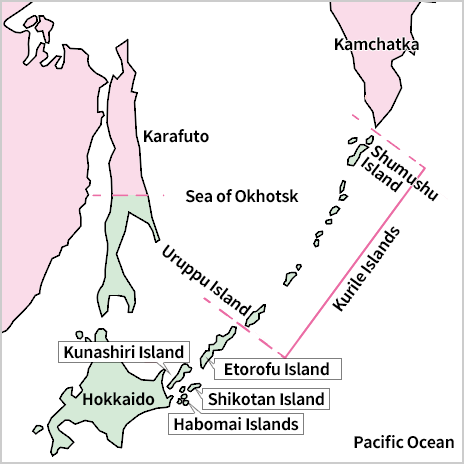
3. Defeat in war and Soviet occupation
In 1941 (Showa 16), the Japanese navy’s aircraft-carrier task forces, which rallied at Hitokappu Bay on Etorofu Island, headed for Pearl Harbor, in Hawaii, and the Pacific War broke out on December 8. Prior to the war, in April of that year, Japan and the Soviet Union had ratified the Neutrality Pact between the Soviet Union and Japan, promising mutual nonaggression.
However, in April 1945, when Japan’s defeat seemed likely, the Soviet Union declared its intention of not extending the Neutrality Pact between the Soviet Union and Japan, which was still valid until the following year. Russia's intent was to enter the war against Japan, which the Soviet Union had promised in secret at the Yalta Conference. On August 8 of that year, despite the still-effective Neutrality Pact between the Soviet Union and Japan, the Soviet Union suddenly declared war on Japan, and 1.6 million Soviet Far Eastern troops crossed the Soviet-Manchurian border and launched attacks. In Karafuto, on August 11, approximately 35,000 Soviet soldiers invaded across the border at 50 degrees north latitude and fought roughly 20,000 Japanese troops. A few days later, on August 14, Japan accepted the Potsdam Declaration. The war ended with Japan's unconditional surrender.
However, the Soviet troops continued their attack even after Japan accepted the Potsdam Declaration, landing on Shumushu Island on August 18 and engaging with about 25,000 Japanese garrisoned troops. They continued advancing southward while disarming Japanese soldiers stationed in various parts of the Kuril Islands, landed on Etorofu Island on August 28, and reached Kunashiri Island and Shikotan Island on September 1 and the Habomai Islands on September 3, occupying all four northern islands by September 5.
Despite the principle of no territorial expansion espoused by the Allies in the Atlantic Charter and the Cairo Declaration, the Soviet Union issued the Soviet Union Supreme Conference Executive Order on the Establishment of Southern Sakhalin Oblast on February 2, 1946 (Showa 21), and incorporated the four northern islands into Soviet territory. The Cairo Declaration states that Japan must be expelled from areas that “Japan has taken by violence and greed.” However, the four northern islands had never been Russian territory, and it is clear from history that this declaration does not apply.
Some of the people who lived on the islands were worried because they had lost contact with Hokkaido, and they took the risk of escaping. People who were unable to abandon their hometowns and remained on the islands were forcibly repatriated to Japan from 1947 (Showa 22) to 1949 (Showa 24). Since this time, Russian occupation without legal grounds has continued.
4. The San Francisco Peace Treaty and the restoration of Japan–Soviet relations
At the San Francisco Peace Conference in 1951 (Showa 26), the San Francisco Peace Treaty was signed between Japan and 48 countries, not including the Soviet Union, and Japan restored its sovereignty and returned to the international community. Japan waived its rights, title, and claims to the Kurile Islands and Minami Karafuto south of 50 degrees north latitude. Prime Minister Yoshida mentioned not only that the Habomai Islands and Shikotan Island constituted an integral part of Japan but also that both Kunashiri and Etorofu had long been parts of Japanese territory, drawing the attention of the participants at this meeting to these facts. In addition, US plenipotentiary Dulles stated that the terms of the Potsdam surrender constituted the only peace treaty binding Japan and the Allies as a whole, and that while there were private agreements between some Allies, neither Japan nor any other Allies would been bound by those agreements.
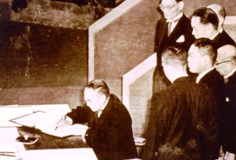
Talks and negotiations were held from June 1955 (Showa 30) to the following year to conclude a separate peace treaty with the Soviet Union, which refused to sign the San Francisco Peace Treaty. The US government supported Japan, stating in the US Memorandum of Understanding on the Negotiations between Japan and the Soviet Union, “The United States has reached the conclusion after careful examination of the historical facts that the islands of Etorofu and Kunashiri (along with the Habomai Islands and Shikotan which are a part of Hokkaido) have always been part of Japan proper and should in justice be acknowledged as under Japanese sovereignty.” However, negotiations between Japan and the Soviet Union on the Northern Territories faltered, and no agreement was reached. As a result, peace treaty negotiations involving the territorial dispute were to be conducted after the establishment of normal diplomatic relations. October 19, 1956, the Japan-Soviet Joint Declaration was signed, and diplomatic relations were restored between Japan and the Soviet Union. Article 9 of the Joint Declaration stated: “The Union of Soviet Socialist Republics and Japan agree to continue, after the restoration of normal diplomatic relations between the Union of Soviet Socialist Republics and Japan, negotiations for the conclusion of a Peace Treaty. In this connexion, the Union of Soviet Socialist Republics, desiring to meet the wishes of Japan and taking into consideration the interests of the Japanese State, agrees to transfer to Japan the Habomai Islands and the island of Shikotan, the actual transfer of these islands to Japan to take place after the conclusion of a Peace Treaty between the Union of Soviet Socialist Republics and Japan.”
